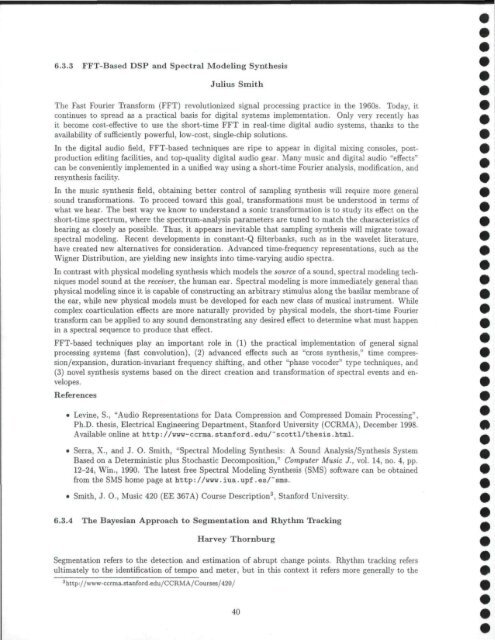CCRMA OVERVIEW - CCRMA - Stanford University
CCRMA OVERVIEW - CCRMA - Stanford University
CCRMA OVERVIEW - CCRMA - Stanford University
Create successful ePaper yourself
Turn your PDF publications into a flip-book with our unique Google optimized e-Paper software.
6.3.3 FFT-Based DSP and Spectral Modeling Synthesis<br />
Julius Smith<br />
The Fast Fourier Transform (FFT) revolutionized signal processing practice in the 1960s. Today, it<br />
continues to spread as a practical basis for digital systems implementation. Only very recently has<br />
it become cost-effective to use the short-time FFT in real-time digital audio systems, thanks to the<br />
availability of sufficiently powerful, low-cost, single-chip solutions.<br />
In the digital audio field, FFT-based techniques are ripe to appear in digital mixing consoles, postproduction<br />
editing facilities, and top-quality digital audio gear. Many music and digital audio "effects"<br />
can be conveniently implemented in a unified way using a short-time Fourier analysis, modification, and<br />
resynthesis facility.<br />
In the music synthesis field, obtaining better control of sampling synthesis will require more general<br />
sound transformations. To proceed toward this goal, transformations must be understood in terms of<br />
what we hear. The best way we know to understand a sonic transformation is to study its effect on the<br />
short-time spectrum, where the spectrum-analysis parameters are tuned to match the characteristics of<br />
hearing as closely as possible. Thus, it appears inevitable that sampling synthesis will migrate toward<br />
spectral modeling. Recent developments in constant-Q filterbanks, such as in the wavelet literature,<br />
have created new alternatives for consideration. Advanced time-frequency representations, such as the<br />
Wigner Distribution, are yielding new insights into time-varying audio spectra.<br />
In contrast with physical modeling synthesis which models the source of a sound, spectral modeling techniques<br />
model sound at the receiver, the human ear. Spectral modeling is more immediately general than<br />
physical modeling since it is capable of constructing an arbitrary stimulus along the basilar membrane of<br />
the ear, while new physical models must be developed for each new class of musical instrument. While<br />
complex coarticulation effects are more naturally provided by physical models, the short-time Fourier<br />
transform can be applied to any sound demonstrating any desired effect to determine what must happen<br />
in a spectral sequence to produce that effect.<br />
FFT-based techniques play an important role in (1) the practical implementation of general signal<br />
processing systems (fast convolution), (2) advanced effects such as "cross synthesis," time compression/expansion,<br />
duration-invariant frequency shifting, and other ''phase vocoder" type techniques, and<br />
(3) novel synthesis systems based on the direct creation and transformation of spectral events and envelopes.<br />
References<br />
• Levine, S., "Audio Representations for Data Compression and Compressed Domain Processing",<br />
Ph.D. thesis, Electrical Engineering Department, <strong>Stanford</strong> <strong>University</strong> (<strong>CCRMA</strong>), December 1998.<br />
Available online at http://www-ccrma.stanford.edu/~scottl/thesis.htinl.<br />
• Serra, X., and J. 0. Smith, "Spectral Modeling Synthesis: A Sound Analysis/Synthesis System<br />
Based on a Deterministic plus Stochastic Decomposition," Computer Music J., vol. 14, no. 4, pp.<br />
12-24, Win., 1990. The latest free Spectral Modeling Synthesis (SMS) software can be obtained<br />
from the SMS home page at http://www.iua.upf.es/~sms.<br />
• Smith, J. 0., Music 420 (EE 367A) Course Description 3 , <strong>Stanford</strong> <strong>University</strong>.<br />
6.3.4 The Bayesian Approach to Segmentation and Rhythm Tracking<br />
Harvey Thornburg<br />
Segmentation refers to the detection and estimation of abrupt change points. Rhythm tracking refers<br />
ultimately to the identification of tempo and meter, but in this context it refers more generally to the<br />
3 http://www-ccrma.stanford.edu/<strong>CCRMA</strong>/Courses/420/<br />
10

















